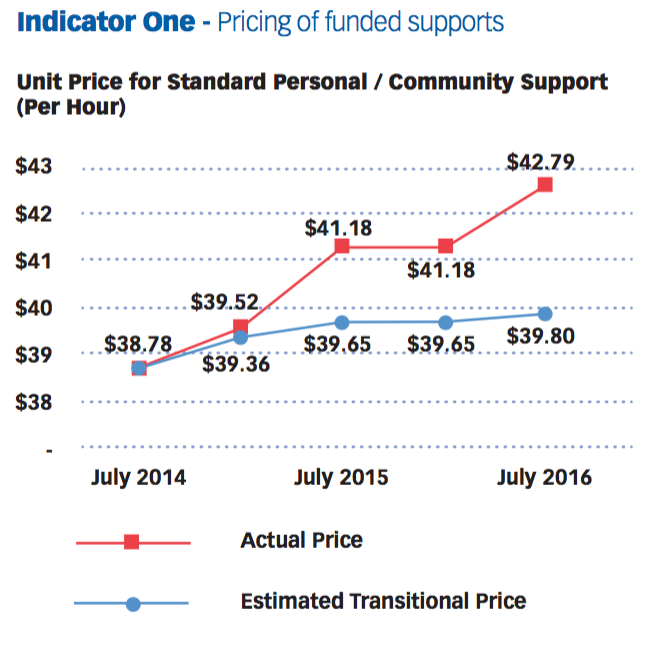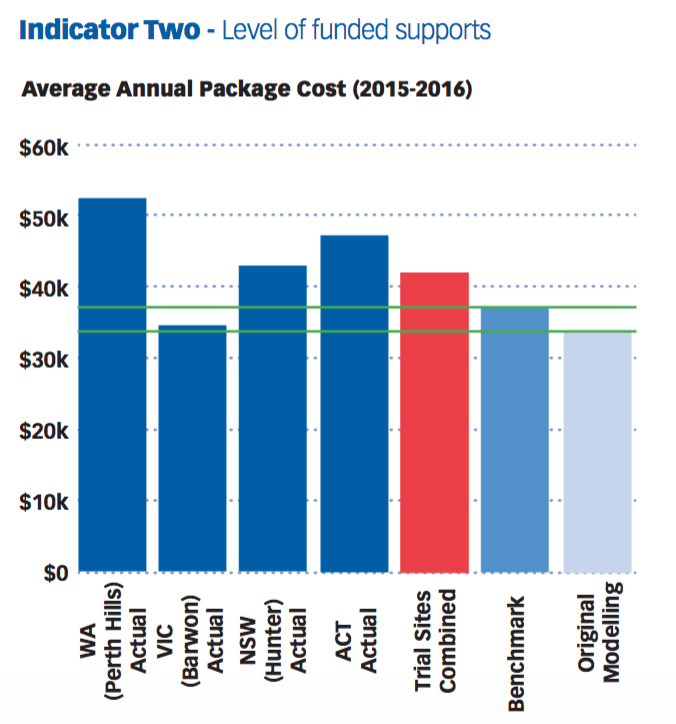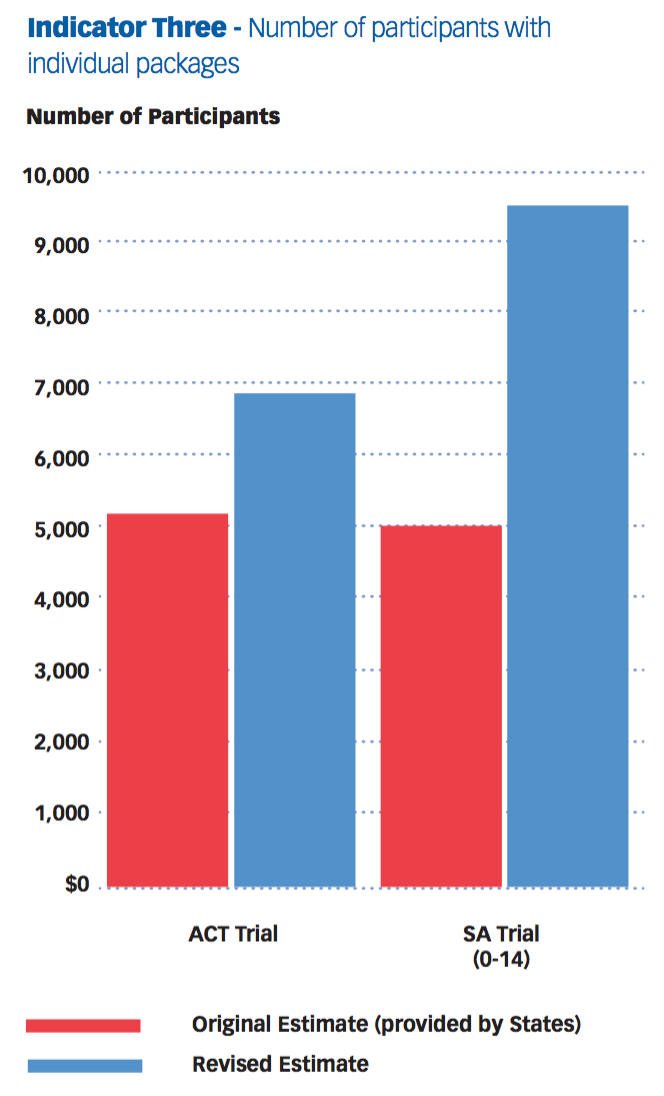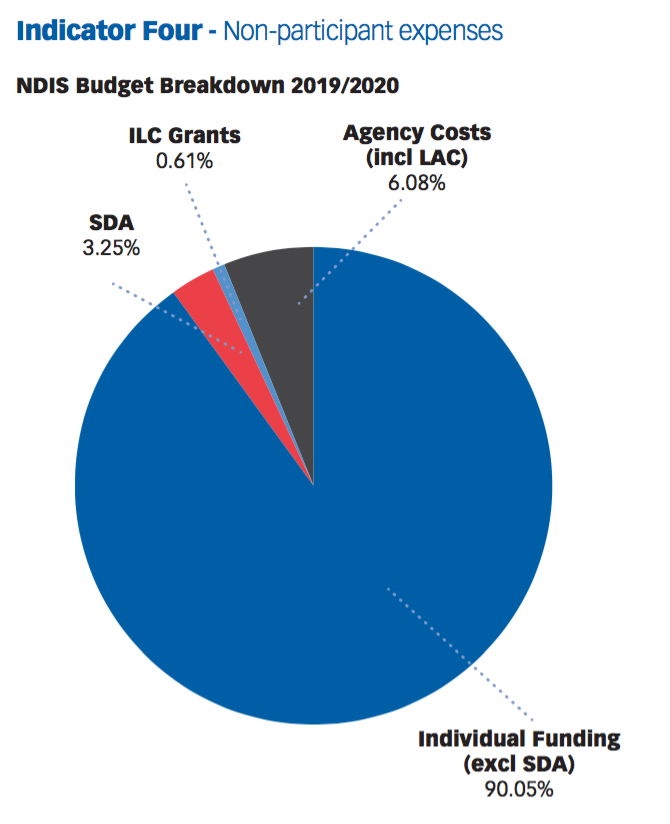Indicators to keep an eye on
The National Disability Insurance Scheme (NDIS) is already wreaking significant change on the disability support sector.
The NDIS will fund 460,000 individual support packages for eligible participants, plus “information, linkage and capacity building” for people who are deemed ineligible. The total annual budget for the NDIS is set at $22 billion, following the full implementation of the scheme in 2019-20.
The question remains though, is $22 billion enough? Is the NDIS financially sustainable in its current shape and form?
This article will outline the four key indicators that will determine the financial sustainability of the NDIS, as well as advice for both consumers and providers within the scheme.


In 2014, the government’s plan was to step down to an efficient unit price for standard personal/community support by July 2016. The original estimated efficient price was $39.80/hour (future value after indexation and Equal Remuneration Order adjustments).
However, the reality is that as of July 2016, the actual price is $42.79/hour ($43.58/hour for ACT/SA/WA/NT) - 7.5% higher than anticipated.

The average annual package cost is an important indicator that combines the effects of price and service level of supports funded. The original modeled average cost by the Productivity Commission was $34,969. The National Disability Insurance Agency’s (NDIA) benchmark or “target” for 2015-16 was $38,588.
The actual average annual package cost for the four trial sites combined (Hunter, Barwon, Canberra and Perth Hills - other sites that have either just commenced transition or have an age-biased participant population have been excluded) was $43,275, exceeding the benchmark by 12%, and 24% higher than originally modelled.

The number of participants estimated to receive individual packages under the NDIS (i.e. becoming “participants”) at full scheme was 460,000. There are early signs that the actual number of participants eligible for individual funding may be significantly higher, as demonstrated in the chart above.
Trial site experience so far has revealed that the estimated number of participants has been raised by 36% in the ACT across all ages and 68% in South Australia for children up to the age of 14, which is a significant increase.

There are three categories of non-participant expenses that make up approximately 10% of the NDIS total budget, on top of individual funding to participants:
1. Specialist Disability Accommodation (SDA) funding - $700m budget
Although SDA will be included in participants’ NDIS plans, it will only be paid directly to registered SDA providers of enrolled properties, as a contribution towards capital costs of land and buildings. SDA only commenced from July 2016, and will have an annual budget of $700 million when the NDIS is fully rolled out.
2. Information, Linkage, and Capacity Building (ILC) grants - $131m budget
ILC is expected to support 900,000 people with a disability who will not be eligible for individual funding. The grants component of this funding stream will have an annual budget of $131 million. The Local Area Coordination (LAC) component of ILC is included in Agency Costs (below).
3. Agency Costs including LAC - $1.3 billion budget
At full scheme, the $1.3 billion budgeted for agency costs is expected to cover all operating costs of the NDIA and the outsourced LAC function.
The combined effect
The above factors determine the total budget required for the NDIS. If the average package cost is 12% higher than budgeted, as across the four trial sites so far, and the number of participants increases by 36% as seen in the ACT, then the whole scheme would have a 47% or over $10 billion budget blowout by the time it has fully rolled out.
If this is going to be the case, the government may take one or a combination of the following actions to address this discrepancy in the budget:
1. Tighten up prices
Given the price points for personal and community supports are already very low, supported accommodation and allied health therapy prices may be scrutinised and tightened, as these two services are perceived to be lucrative under the current fee schedule.
2. Co-payments
Participants may be asked to make a co-contribution towards their package costs (like an insurance excess) or pay a gap fee when using “non-bulk billing” services. Many quality services may be deemed as “non-bulk billing”.
3. Reduce the level of supports people receive within their packages
This could be done in a number of ways, including
- universally cutting back hours and budgets by adopting leaner Reference Packages;
- gradually reducing certain supports or restricting them to once off, such as support coordinating and therapy; or,
- tightening up eligibility criteria for “high and complex needs” and access to higher levels of supports.
In trial sites, we have seen significant budget reduction in some individuals’ second or third plans compared with their first plans.
4. Tighten up eligibility for individual packages
The NDIS is not a capped scheme, so there is no ceiling for the total number of participants. However, access criteria may be adjusted to make it harder for people with lower levels of needs to access individual funding.
5. Reduce the budget for non-participant expenses
Insignificant savings may be achieved through outsourcing/reducing other functions of the NDIA in addition to the LAC.
Advice for people with a disability
The budget pressure means it may become harder to access the scheme, plan budgets may be reduced, and individuals may be asked to make co-payments.
To protect your own interest, the following actions should be taken:
-
Submit your access request and book planning meetings as soon as the NDIS starts rolling out in your area or for your age group;
-
Prepare yourself before the planning meeting by reviewing your support needs, prioritising, substantiating and articulating your needs, and try to include everything you can as long as they are “necessary and reasonable”;
-
Use up your package budget within the plan period as you may not get the same level of funding again next year (unless there is a valid reason, e.g. no provider/long waits); and,
-
Set reasonable expectations about the level and continuity of certain supports within your individual funding packages.
Advice for service providers
As a service provider, if you expect the NDIS to be a significant source of income, then be prepared for (more) changes to how plans are constructed and funds are allocated, and take the following actions:
-
Review your business model regularly, conduct scenario analysis and test how and to what extent your organisation would be affected by changes in NDIS prices, service demand, service mix and costs;
-
Consider whether and how to grow and diversify. Generally, growth gives you larger scale to derive efficiency and reduce costs, whilst diversification means eggs are not kept in one basket;
-
Be agile. Maintain sufficient cash reserve and a flexible workforce. If you need additional fixed assets, try leasing rather than outright purchasing. If you need to upgrade IT systems, try cloud-based solutions; and
-
Stay tuned to changes and developments of the NDIS. Read NDIA’s quarterly reports, dashboards and market position statements, ask peer organisations in trial sites about their experience, and analyse your clients’ NDIS plans for trends.
How can Nexia Australia help?
The NDIS takes a flexible, whole-of-life approach to working with participants, their families and carers, to develop individualised plans. The NDIS provides participants with more choice and control over how, when and where their supports are provided.
Nexia Australia’s NDIS specialists can assist current and future service providers with NDIS transitioning, costing and pricing, business models and processes as well as procedures.
Contact your local Nexia Advisor today to start your personal NDIS conversation.


